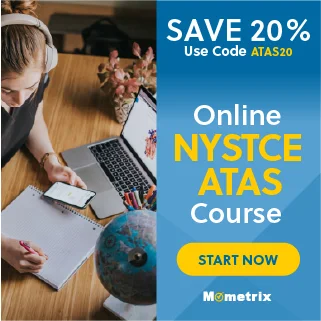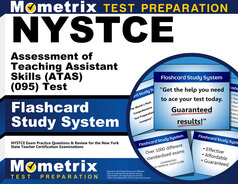Even the best teacher may need someone to help them in the classroom. Teaching assistants provide invaluable assistance working with students under the supervision of a certified teacher. They must be well versed in the principles of reading, writing, math, and instructional support.
But before teaching assistants enter the classroom, they must pass the New York State Teacher Certification Examinations (NYSTCE) Assessment of Teaching Assistant Skills (ATAS) (095) Test.
Click “Start Test” above to take a free NYSTCE ATAS practice test!
NYSTCE ATAS Exam Outline
The NYSTCE ATAS (095) exam contains 100 multiple-choice questions, and you will be given 3 hours to complete it.
The questions are split into four subcategories:
1. Reading (27%)
The questions in this section assess your ability to understand and interpret various aspects of the reading process. As you move through the Reading section, you will be given a selection of passages to read and answer questions about.
Here is a closer look at the topics covered in this section:
General vocabulary
- Determine the meaning of common words
- Identify synonyms and antonyms of given words
- Recognize the correct use of often-misused homophones (their/there, to/too, etc.)
Main idea of a passage
- Identify a passage’s main idea
- Identify topic sentences
- Recognize introductory and summary statements
- Select an accurate restatement of a passage’s main idea
Sequence of ideas
- Identify the order of events in a passage
- Organize instructions into their proper sequence
- Identify cause-and-effect relationships
Textual and graphic information
- Interpret data from tables, graphs, and charts
- Recognize correct representations of information in graph or table form
- Recognize facts and opinions
2. Writing (27%)
The questions in this section assess your ability to understand various aspects of written English.
Here is a closer look at the topics covered in this section:
Verb usage
- Identify subject-verb agreement
- Identify verb tense
- Recognize verb tense consistency
Pronouns and modifiers
- Identify pronoun-antecedent agreement
- Understand possessive pronouns, relative pronouns, and demonstrative pronouns
- Understand comparative and superlative modifiers
Sentence structure and punctuation
- Identify sentence fragments
- Identify run-on sentences
- Identify correct and incorrect punctuation
Capitalization and spelling
- Identify correct capitalization at the beginning of sentences
- Identify correct capitalization of proper words and titles
- Recognize correct spelling of common words
3. Mathematics (27%)
The questions in this section assess your ability to understand and apply various aspects of basic mathematics.
Here is a closer look at the topics covered in this section:
Number concepts
- Identify place values
- Identify correctly rounded numbers
- Identify equivalent weights and measures
- Estimate solutions to measurement problems
Addition and subtraction of whole numbers
- Solve whole-number addition problems
- Solve whole-number subtraction problems
- Apply addition and subtraction principles to real-life situations
Multiplication and division of whole numbers
- Solve whole-number multiplication problems
- Solve whole-number division problems
- Apply multiplication and division principles to real-life situations
Operations involving fractions, percents, and decimals
- Solve fraction problems
- Solve decimal problems
- Solve percent problems
- Solve problems involving converting between fractions, percents, and decimals
4. Instructional Support (19%)
The questions in this section assess your ability to understand various aspects of classroom instruction.
Here is a closer look at the topics covered in this section:
Teaching reading
- Provide support for various learning styles, student needs, and background experiences
- Help students use instructional resources
- Help students use a variety of reading comprehension approaches
- Gather information about students’ progress
Teaching writing
- Understand drafting, editing, and proofreading
- Help students focus their writing
- Help students use instructional resources
- Gather information about students’ progress
Teaching mathematics
- Relate mathematics to everyday scenarios
- Identify and correct basic mathematical errors
- Help students use instructional resources
- Gather information about students’ progress
Check Out Mometrix's NYSTCE ATAS Study Guide
Get practice questions, video tutorials, and detailed study lessons
Get Your Study Guide
Registration
To register for the exam, you will need to create an NYSTCE account and complete the registration process there. It is recommended that you complete the registration process at least 30 days in advance of taking the exam.
During this process, you will be asked some questions about your educational history, as well as your current education level, first language, matriculation status, and the education code for the NYC Department of Education program type you are associated with.
The fee to take the exam is $54.
Test Day
On the day of the test, you should arrive at the testing center at least 15 minutes earlier than the scheduled exam time.
When you arrive, you will be asked to provide a valid form of photo ID. If you do not bring proper identification or your ID is deemed invalid, you will not be let into the testing room.
Before the test begins, you will be asked to place all personal items in a locker outside the testing room, or you may be asked to leave them in your car. Personal items include your phone, calculator, books, notes, bag/backpack, hat, food, highlighters, and any recording devices.
Once the test begins, you will be allowed to take breaks. However, the timer will not be stopped during your break, so you must use your break time carefully.
How the Exam is Scored
Your total score is reported within the range of 100-300 and is based on your performance on all sections of the test. To pass the exam, you must achieve a scaled score of 220.
You should receive your test results roughly 2-4 weeks after taking the exam. When you receive your score report, you will see your total score, your pass/fail status, and your scores for each subarea of the test. The New York State Education Department (NYSED) will receive your scores, and they will add the scores to your certification application file.

NYSTCE ATAS Test Online Prep Course
If you want to be fully prepared, Mometrix offers an online NYSTCE ATAS prep course designed to give you everything you need to succeed!
Here’s what you’ll find in the NYSTCE ATAS course:
- 60+ Review Lessons Covering Every Topic
- Over 500 NYSTCE ATAS Practice Questions
- 170+ Video Tutorials
- 500+ Digital Flashcards
- Money-back Guarantee
- Mobile Access
Everyone learns differently, so we’ve tailored the NYSTCE ATAS online prep course to ensure every learner has what they need to prepare for the NYSTCE ATAS exam.
Click below to check it out!
Check Out Mometrix's NYSTCE ATAS Flashcards
Get complex subjects broken down into easily understandable concepts
Get Your Flashcards
FAQs
Q
How many questions are on the NYSTCE ATAS exam?
A
There are 100 multiple-choice questions on the exam.
Q
How long is the NYSTCE ATAS exam?
A
The time limit for the exam is 3 hours.
Q
What is the passing score for the NYSTCE ATAS exam?
A
To pass this exam, you will need to achieve a scaled score of 220.
Q
How much does the NYSTCE ATAS exam cost?
A
The exam fee is $54.


